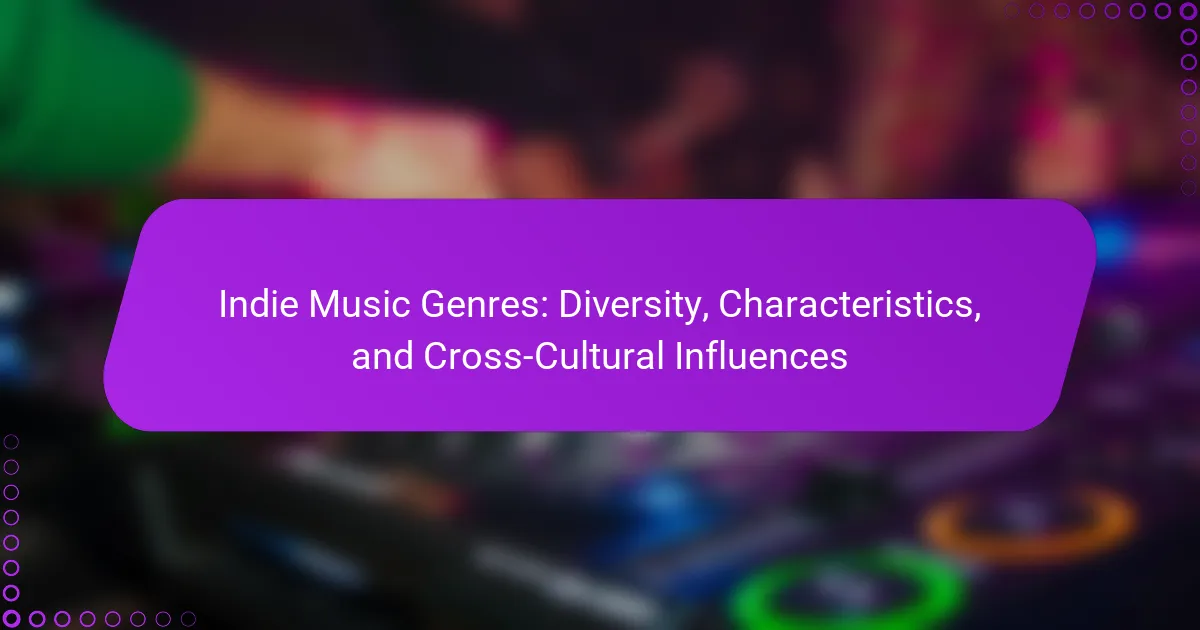Indie music genres offer a rich tapestry of sounds, characterized by their artistic independence and diverse influences. This article explores the unique attributes of various indie genres, the impact of regional diversity, and emerging trends shaping the music landscape. It also addresses the challenges faced by indie artists and highlights notable figures leading the genre. Supporting strategies for indie musicians will be discussed to enhance their creative expression and audience reach.

What defines the essence of indie music genres?
Indie music genres are defined by their diversity, unique characteristics, and cross-cultural influences. These genres often prioritize artistic expression over commercial success, leading to a rich variety of sounds and styles. Root attributes include independence from major record labels and a DIY ethos. Unique attributes may involve specific regional influences, such as folk elements in indie folk or electronic experimentation in indie pop. Rare attributes can include unconventional instrumentation or lyrical themes that challenge mainstream norms. This eclecticism fosters a vibrant musical landscape that continually evolves.
How do indie music genres differ from mainstream music?
Indie music genres differ from mainstream music through their emphasis on artistic freedom and diverse influences. Indie music often prioritizes creativity over commercial success, resulting in unique sounds and varied cultural expressions. Mainstream music typically follows popular trends and formulas, aiming for mass appeal. Indie genres may explore niche themes and unconventional instrumentation, reflecting personal or cultural narratives. This contrast creates a rich tapestry of musical expression, showcasing the individuality of artists within the indie scene.
Which cultural movements have influenced indie music?
Indie music has been influenced by various cultural movements, including punk, folk, and alternative rock. Punk’s DIY ethos shaped indie’s independent spirit. Folk revival introduced acoustic elements, while alternative rock expanded genre boundaries. Other influences include post-punk, grunge, and electronic music, each contributing unique sounds and aesthetics to the indie landscape.
What are the common characteristics of indie music genres?
Indie music genres share several common characteristics, including a focus on artistic expression, diverse influences, and a DIY ethos. Many indie artists prioritize creative freedom over commercial success, allowing for experimental sounds and unique lyrical themes. Cross-cultural influences often enrich the music, blending genres and styles. Additionally, indie music typically features a range of instrumentation and production techniques, contributing to its distinctive sound.

How does regional diversity shape indie music genres?
Regional diversity significantly influences indie music genres by introducing unique sounds and cultural elements. Local traditions, languages, and social contexts shape the music’s characteristics. For instance, indie folk from the Appalachian region incorporates traditional instruments, while West Coast indie rock often features surf culture influences. This cross-cultural exchange fosters innovation, leading to rare genre hybrids. Additionally, regional variations can create distinct sub-genres, enhancing the overall diversity of the indie music landscape.
What are the unique sounds of indie music in Europe?
Indie music in Europe features unique sounds characterized by diverse genres, regional influences, and innovative production techniques. Each country contributes distinct elements, such as the lo-fi aesthetics of the UK, the melodic folk influences in Scandinavia, and the experimental sounds emerging from Eastern Europe. This variety reflects cultural narratives and social themes, enriching the indie music landscape across the continent. Collaboration among artists from different regions further enhances this diversity, leading to cross-cultural fusions that define contemporary European indie music.
How do Latin American influences manifest in indie music?
Latin American influences manifest in indie music through diverse rhythms, instrumentation, and lyrical themes. Genres like Latin rock and cumbia blend with indie styles, creating unique soundscapes. Artists often incorporate traditional instruments, such as the charango or marimba, enhancing authenticity. This fusion showcases cultural narratives, reflecting social issues and personal experiences unique to Latin American contexts. As a result, indie music becomes a platform for cross-cultural dialogue, enriching the global music scene.
What role does Japanese indie music play in global trends?
Japanese indie music significantly influences global trends by blending traditional sounds with contemporary styles. This fusion creates a unique sound that resonates with diverse audiences. Artists often incorporate elements from various genres, promoting cross-cultural collaborations. The rise of digital platforms has facilitated international exposure, allowing Japanese indie music to reach wider audiences. This trend reflects a growing appreciation for global diversity in music.
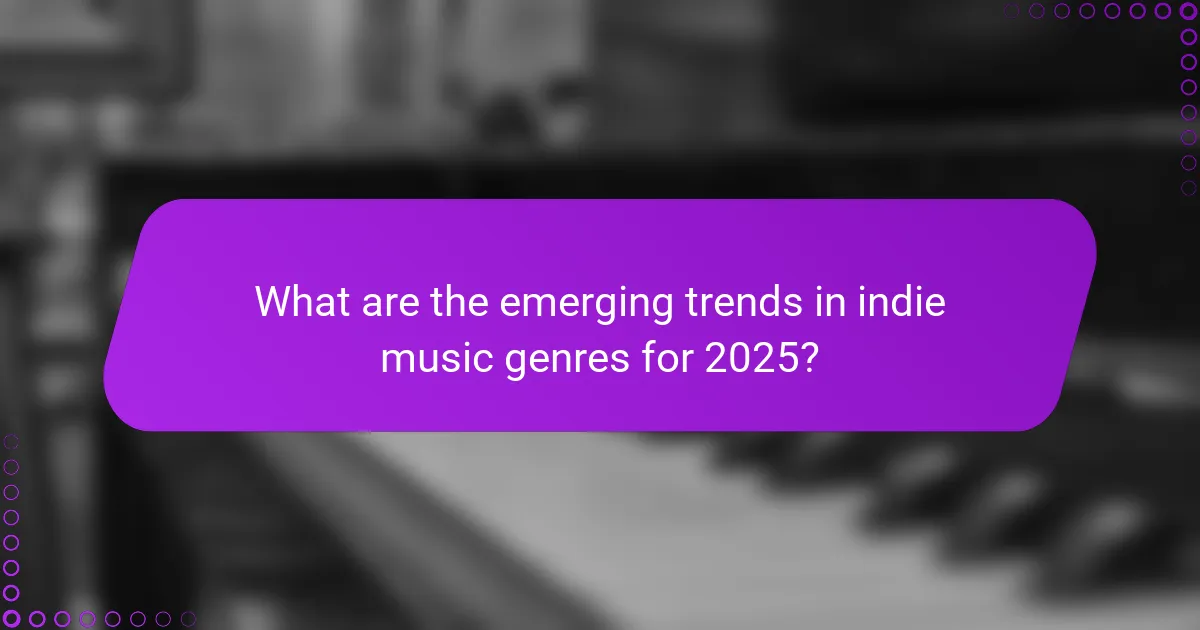
What are the emerging trends in indie music genres for 2025?
Indie music genres are expected to embrace increased diversity, innovative collaborations, and global influences by 2025. Emerging trends include the fusion of genres, where artists blend elements of folk, electronic, and hip-hop, creating unique soundscapes.
Cross-cultural influences will play a significant role, as artists draw inspiration from various musical traditions worldwide. This trend enhances the richness of indie music, allowing for a broader audience appeal. Additionally, technology will continue to shape music production and distribution, enabling indie artists to reach listeners directly and experiment with new sounds.
Sustainability in music production may also emerge as a priority, with artists focusing on eco-friendly practices. As a result, the indie music scene will likely reflect a commitment to social issues, resonating with a socially conscious audience.
Which innovative platforms are shaping indie music distribution?
Innovative platforms shaping indie music distribution include Bandcamp, DistroKid, and TuneCore. These platforms empower artists by providing direct access to audiences and flexible distribution options. Bandcamp allows musicians to set their own prices, fostering a unique artist-fan relationship. DistroKid offers rapid distribution to major streaming services, making it easy for indie artists to reach wider audiences. TuneCore provides comprehensive analytics, helping artists understand their listener demographics. Together, these platforms enhance the visibility and accessibility of indie music globally.
How is technology influencing indie music production?
Technology significantly influences indie music production by enhancing accessibility and creative possibilities. Digital audio workstations allow artists to produce high-quality music from home. Streaming platforms provide exposure and distribution opportunities previously unavailable to independent musicians. Social media facilitates direct engagement with fans, fostering community and collaboration. Additionally, affordable recording equipment democratizes sound quality, enabling diverse genres to flourish. This technological landscape nurtures innovation and cross-cultural influences in indie music.
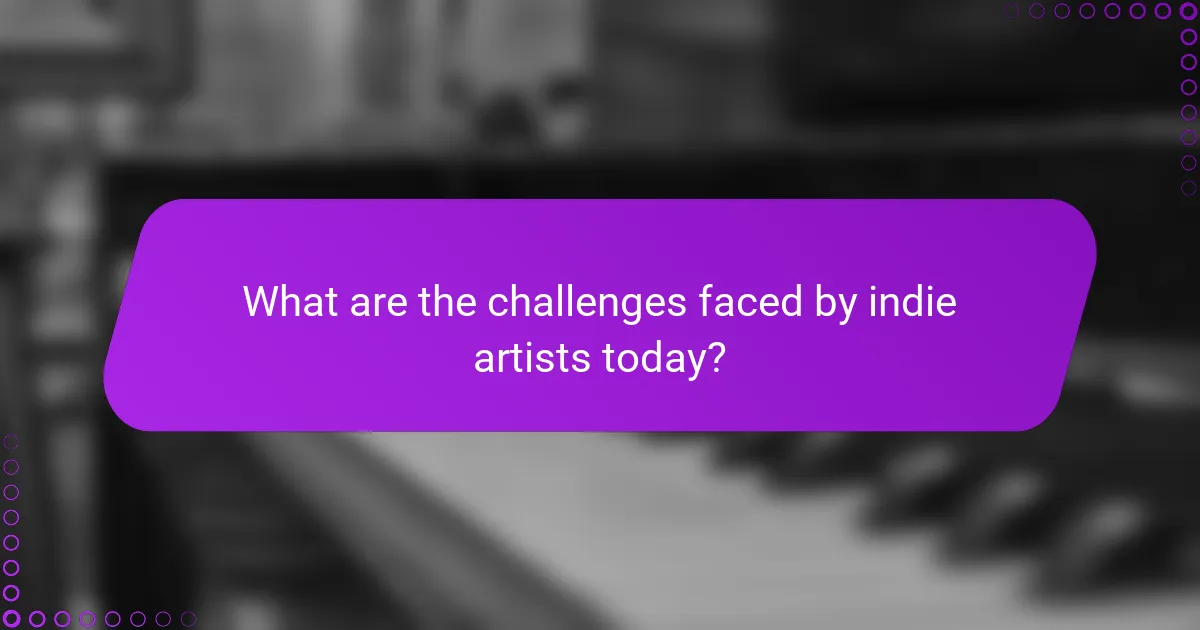
What are the challenges faced by indie artists today?
Indie artists today face various challenges that hinder their growth. Key issues include limited financial resources, difficulty in gaining exposure, and navigating the digital landscape.
Financial constraints often prevent indie artists from accessing professional production, marketing, and distribution services. Limited budgets can restrict their ability to create high-quality music and engage in promotional activities.
Exposure remains a significant hurdle, as the music industry is saturated with talent. Indie artists struggle to stand out in a crowded market, making it challenging to reach wider audiences.
Navigating digital platforms poses another challenge. While streaming services provide opportunities, they also create competition and complex algorithms that can obscure an artist’s visibility.
Overall, these challenges impact an indie artist’s ability to thrive in a dynamic music environment.
How do indie artists navigate funding and promotion?
Indie artists navigate funding and promotion through diverse strategies, including crowdfunding, social media, and partnerships. Crowdfunding platforms like Kickstarter allow artists to raise funds directly from fans. Social media enables targeted promotion and audience engagement, essential for building a loyal fanbase. Collaborations with other artists or brands can also enhance visibility and resources. Unique attributes such as genre blending and cross-cultural influences further enrich their promotional narratives, attracting diverse audiences.
What common pitfalls should indie musicians avoid?
Indie musicians should avoid common pitfalls like neglecting promotion, imitating mainstream trends, and underestimating the importance of networking. These mistakes can hinder artistic growth and audience engagement.
Promoting music effectively is crucial; relying solely on social media may limit reach. Musicians should explore diverse platforms and strategies. Imitating trends can dilute originality, so maintaining a unique sound is essential.
Networking is vital in the indie scene; avoiding collaboration opportunities can stifle growth. Indie musicians should actively seek partnerships and community engagement. Lastly, disregarding feedback can prevent improvement; musicians should embrace constructive criticism to refine their craft.
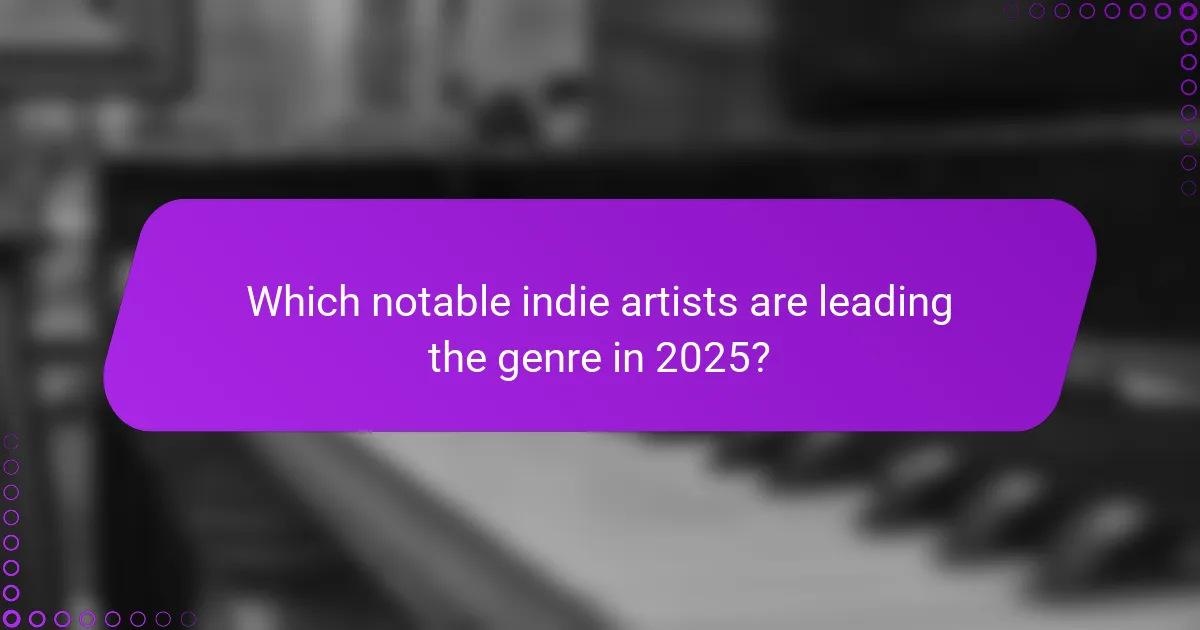
Which notable indie artists are leading the genre in 2025?
In 2025, notable indie artists leading the genre include Phoebe Bridgers, Sufjan Stevens, and Mitski. These artists exemplify diversity in sound and influence.
Phoebe Bridgers combines introspective lyrics with a blend of folk and rock, appealing to a wide audience. Sufjan Stevens is known for his orchestral arrangements and storytelling, pushing genre boundaries. Mitski’s unique voice and emotive themes resonate deeply, showcasing the indie genre’s evolving nature.
These artists reflect the genre’s characteristics, including emotional depth and cross-cultural influences, making indie music a dynamic space in 2025.
What unique attributes do these artists bring to the indie scene?
Indie artists bring distinct influences and styles that enrich the music scene. Their unique attributes include innovative sound experimentation, authentic storytelling, and a strong connection to grassroots culture. Many artists blend genres, creating hybrid sounds that reflect diverse cultural backgrounds. This cross-cultural influence fosters a rich tapestry of musical expression, setting indie music apart from mainstream trends.
How do collaborations enhance the diversity of indie music?
Collaborations enhance the diversity of indie music by blending different genres and cultural influences. This fusion creates unique sounds that appeal to broader audiences. Collaborations often introduce artists to new techniques and perspectives, enriching their musical expression. For instance, an indie rock band may collaborate with a hip-hop artist, merging styles and attracting fans from both genres. Such partnerships foster innovation and expand the creative landscape of indie music.
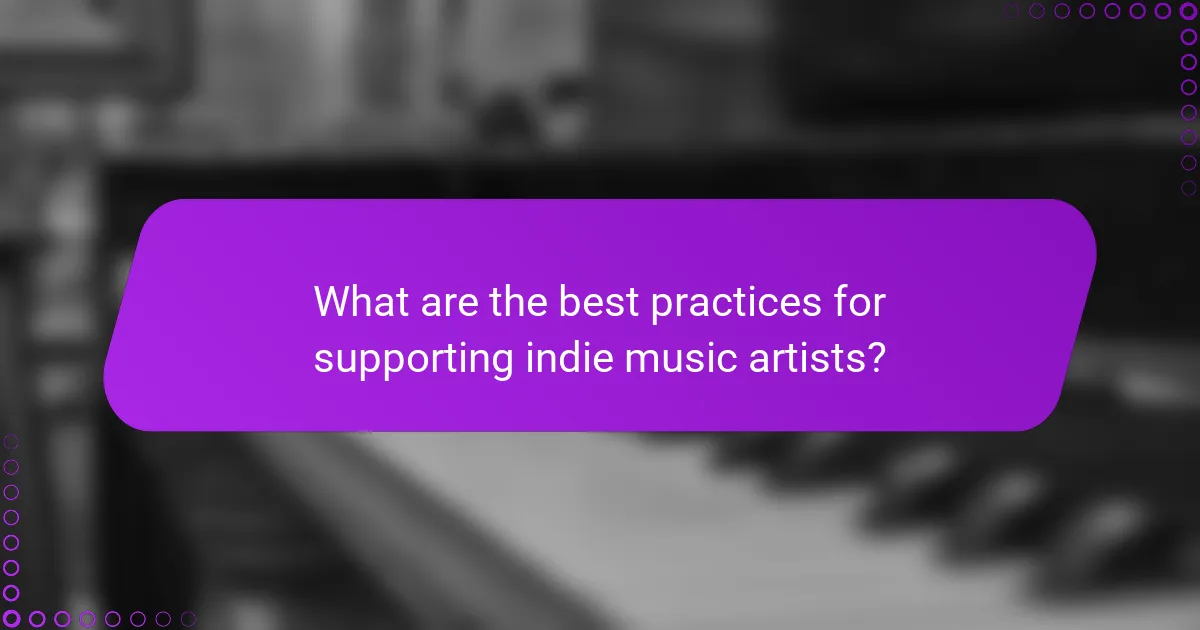
What are the best practices for supporting indie music artists?
Supporting indie music artists involves fostering their creative expression, expanding their audience, and enhancing their financial sustainability.
1. Promote diverse genres: Highlight the variety of indie music genres to attract different listener demographics.
2. Facilitate networking: Connect artists with industry professionals, influencers, and other musicians to create collaborative opportunities.
3. Offer financial support: Encourage crowdfunding, grants, or sponsorships to help artists cover production and marketing costs.
4. Leverage social media: Utilize platforms to share artist content, engage with fans, and build a strong online presence.
5. Organize live events: Create showcases or festivals that feature indie artists, providing them with performance opportunities and exposure.
6. Provide educational resources: Offer workshops or mentorship programs on music production, marketing, and business skills to empower artists.
How can fans effectively promote their favorite indie musicians?
Fans can effectively promote their favorite indie musicians by leveraging social media and local events. Engaging with the artist’s content on platforms like Instagram and Twitter amplifies visibility. Organizing or attending local gigs fosters community support. Collaborating with other fans for promotional campaigns can create a larger impact. Sharing playlists featuring the artist’s music on streaming platforms increases exposure. Engaging in discussions about the artist’s work helps build a dedicated fan base.
What role do music festivals play in the indie music ecosystem?
Music festivals are vital for the indie music ecosystem as they provide exposure, community engagement, and opportunities for collaboration. They showcase diverse indie genres, allowing artists to reach wider audiences. Festivals often highlight unique attributes of indie music, such as grassroots promotion and local culture integration. Moreover, these events foster cross-cultural influences by bringing together artists from various backgrounds, enriching the indie scene. Ultimately, music festivals serve as essential platforms for indie musicians to thrive and connect with fans.
How can artists leverage social media for growth and engagement?
Artists can leverage social media to enhance growth and engagement by building a strong online presence and connecting with diverse audiences. They should focus on creating authentic content that resonates with their target demographic. Engaging regularly through live sessions and interactive posts fosters community and loyalty. Collaborating with other artists across various indie music genres can expand reach and introduce new influences. Utilizing analytics tools helps track engagement metrics, allowing artists to refine their strategies effectively.
